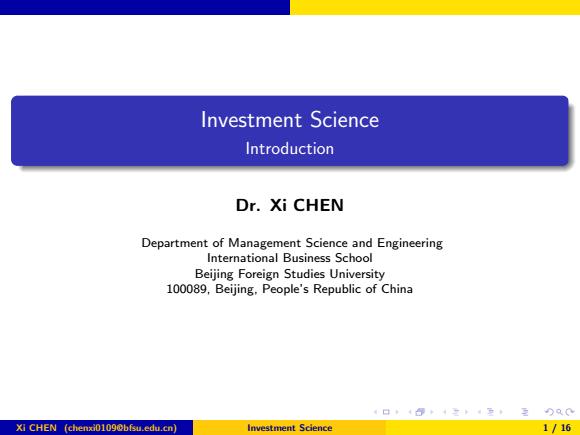
Investment Science Introduction Dr.Xi CHEN Department of Management Science and Engineering International Business School Beijing Foreign Studies University 100089,Beijing.People's Republic of China 4口40+4三4至,至)只0 Xi CHEN (chenxi01090bfsu.edu.cn) Investment Science 1/16
Investment Science Introduction Dr. Xi CHEN Department of Management Science and Engineering International Business School Beijing Foreign Studies University 100089, Beijing, People’s Republic of China Xi CHEN (chenxi0109@bfsu.edu.cn) Investment Science 1 / 16

① Course Information ② Cash Flows Investments and Markets Typical Investment Problems 4口,4得+4艺至,三风0 Xi CHEN (chenxi01090bfsu.edu.cn) Investment Science 2/16
1 Course Information 2 Cash Flows 3 Investments and Markets 4 Typical Investment Problems Xi CHEN (chenxi0109@bfsu.edu.cn) Investment Science 2 / 16
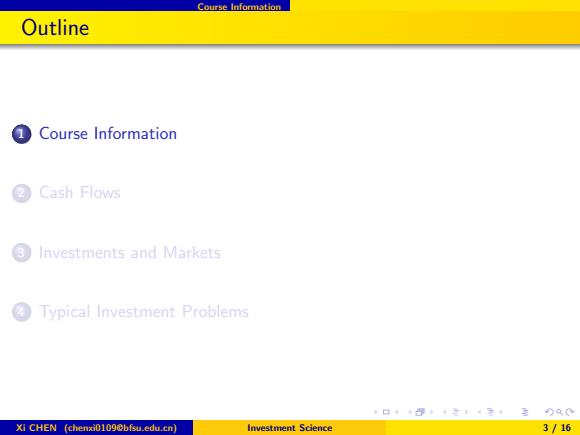
Course Information Outline 0 Course Information Cash Flows Investments and Markets Typical Investment Problems 4口4+4三4至,至)只0 Xi CHEN (chenxi01090bfsu.edu.cn) Investment Science 3/16
Course Information Outline 1 Course Information 2 Cash Flows 3 Investments and Markets 4 Typical Investment Problems Xi CHEN (chenxi0109@bfsu.edu.cn) Investment Science 3 / 16

Course Information o Overview: Deterministic Cash Flow Streams Single-period Random Cash Flow Streams Numerical exercises including fixed income securities and their valuation,and portfolio selection in a single-period,mean-variance context (quadratic programming) ●Textbook: Name Investment Science Author David G.Luenberger Publisher Oxford University Press Edition Second Edition (June 24,2013) ISBN-13 978-0199740086 Programming Tools:Matlab o Preliminaries:Calculus,linear algebra,probability theory,statistics, operations research,C language Xi CHEN (chenxi0109@bfsu.edu.cn) Investment Science 4/16
Course Information Overview: 1 Deterministic Cash Flow Streams 2 Single-period Random Cash Flow Streams 3 Numerical exercises including fixed income securities and their valuation, and portfolio selection in a single-period, mean-variance context (quadratic programming) Textbook: Name Investment Science Author David G. Luenberger Publisher Oxford University Press Edition Second Edition (June 24, 2013) ISBN-13 978-0199740086 Programming Tools: Matlab Preliminaries: Calculus, linear algebra, probability theory, statistics, operations research, C language Xi CHEN (chenxi0109@bfsu.edu.cn) Investment Science 4 / 16
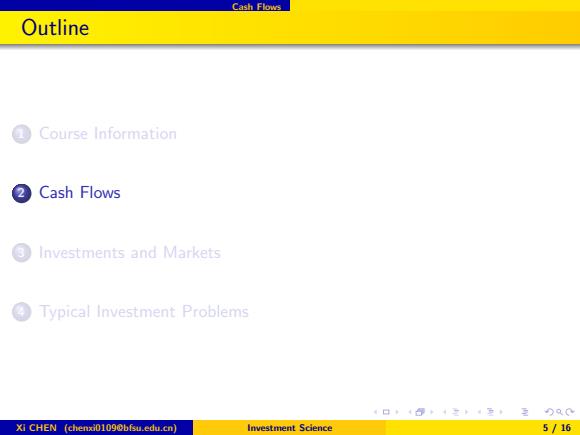
Cash Flows Outline Course Information Cash Flows Investments and Markets Typical Investment Problems 4口40+4三4至,至)只0 Xi CHEN (chenxi01090bfsu.edu.cn) Investment Science 5/16
Cash Flows Outline 1 Course Information 2 Cash Flows 3 Investments and Markets 4 Typical Investment Problems Xi CHEN (chenxi0109@bfsu.edu.cn) Investment Science 5 / 16

Cash Flows Definition oWhen expenditures and receipts are denominated in cash,the net receipts at any time period are termed cash flow,and the series of flows over several periods is termed a cash flow stream.An investment over 4 years might be (-1,0.10,0.10,0.10,1.10) o An investment is defined in terms of its resulting cash flow sequence, namely,the amounts of money that will flow to and from an investor over time. o The investment objective is that of tailoring this cash flow stream to be more desirable than it would be otherwise o Investment science is the application of scientific tools to investments. Time Xi CHEN (chenxi01090bfsu.edu.cn) Investment Science 6/16
Cash Flows Definition When expenditures and receipts are denominated in cash, the net receipts at any time period are termed cash flow, and the series of flows over several periods is termed a cash flow stream. An investment over 4 years might be (-1, 0.10, 0.10, 0.10, 1.10). An investment is defined in terms of its resulting cash flow sequence, namely, the amounts of money that will flow to and from an investor over time. The investment objective is that of tailoring this cash flow stream to be more desirable than it would be otherwise. Investment science is the application of scientific tools to investments. Xi CHEN (chenxi0109@bfsu.edu.cn) Investment Science 6 / 16
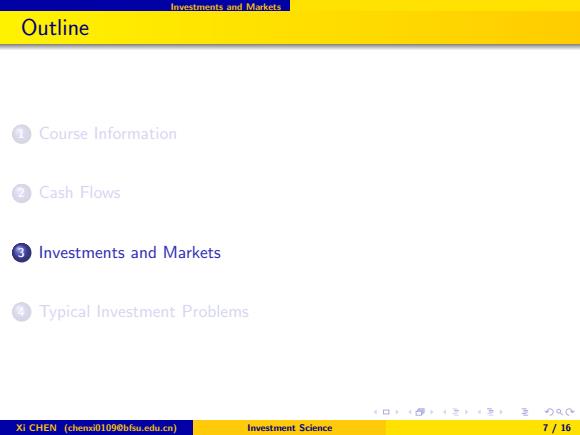
Investments and Markets Outline Course Information Cash Flows Investments and Markets Typical Investment Problems 4口40+4三4至,至)只0 Xi CHEN (chenxi01090bfsu.edu.cn) Investment Science 7/16
Investments and Markets Outline 1 Course Information 2 Cash Flows 3 Investments and Markets 4 Typical Investment Problems Xi CHEN (chenxi0109@bfsu.edu.cn) Investment Science 7 / 16
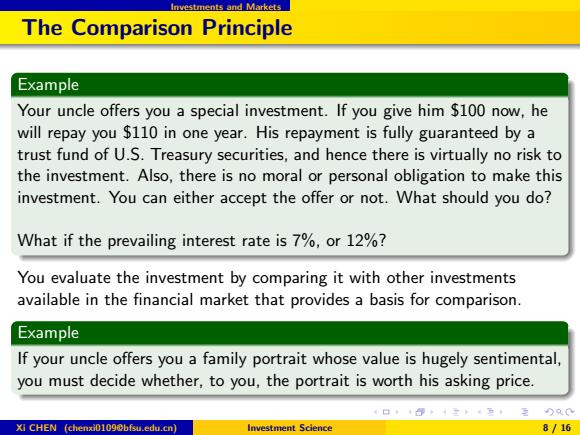
Investments and Markets The Comparison Principle Example Your uncle offers you a special investment.If you give him $100 now,he will repay you $110 in one year.His repayment is fully guaranteed by a trust fund of U.S.Treasury securities,and hence there is virtually no risk to the investment.Also,there is no moral or personal obligation to make this investment.You can either accept the offer or not.What should you do? What if the prevailing interest rate is 7%,or 12%? You evaluate the investment by comparing it with other investments available in the financial market that provides a basis for comparison. Example If your uncle offers you a family portrait whose value is hugely sentimental, you must decide whether,to you,the portrait is worth his asking price. )Q0 Xi CHEN (chenxi01090bfsu.edu.cn) Investment Science 8/16
Investments and Markets The Comparison Principle Example Your uncle offers you a special investment. If you give him $100 now, he will repay you $110 in one year. His repayment is fully guaranteed by a trust fund of U.S. Treasury securities, and hence there is virtually no risk to the investment. Also, there is no moral or personal obligation to make this investment. You can either accept the offer or not. What should you do? What if the prevailing interest rate is 7%, or 12%? You evaluate the investment by comparing it with other investments available in the financial market that provides a basis for comparison. Example If your uncle offers you a family portrait whose value is hugely sentimental, you must decide whether, to you, the portrait is worth his asking price. Xi CHEN (chenxi0109@bfsu.edu.cn) Investment Science 8 / 16
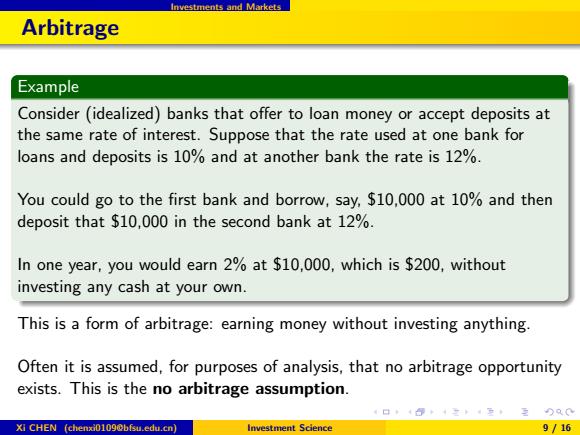
Investments and Markets Arbitrage Example Consider (idealized)banks that offer to loan money or accept deposits at the same rate of interest.Suppose that the rate used at one bank for loans and deposits is 10%and at another bank the rate is 12%. You could go to the first bank and borrow,say,$10,000 at 10%and then deposit that $10,000 in the second bank at 12%. In one year,you would earn 2%at $10,000,which is $200,without investing any cash at your own. This is a form of arbitrage:earning money without investing anything. Often it is assumed,for purposes of analysis,that no arbitrage opportunity exists.This is the no arbitrage assumption. 0Q0 Xi CHEN (chenxi0109@bfsu.edu.cn) Investment Science 9/16
Investments and Markets Arbitrage Example Consider (idealized) banks that offer to loan money or accept deposits at the same rate of interest. Suppose that the rate used at one bank for loans and deposits is 10% and at another bank the rate is 12%. You could go to the first bank and borrow, say, $10,000 at 10% and then deposit that $10,000 in the second bank at 12%. In one year, you would earn 2% at $10,000, which is $200, without investing any cash at your own. This is a form of arbitrage: earning money without investing anything. Often it is assumed, for purposes of analysis, that no arbitrage opportunity exists. This is the no arbitrage assumption. Xi CHEN (chenxi0109@bfsu.edu.cn) Investment Science 9 / 16
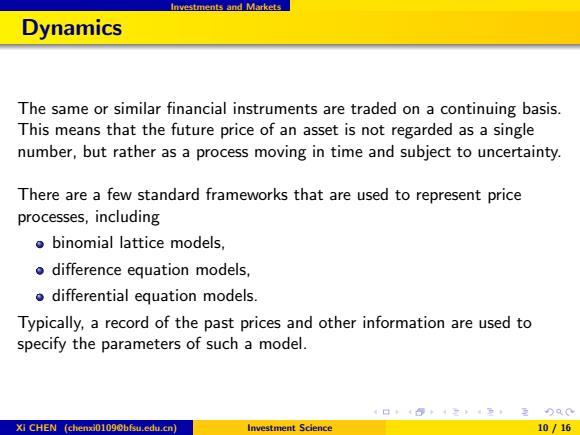
Investments and Markets Dynamics The same or similar financial instruments are traded on a continuing basis. This means that the future price of an asset is not regarded as a single number,but rather as a process moving in time and subject to uncertainty. There are a few standard frameworks that are used to represent price processes,including o binomial lattice models, o difference equation models, o differential equation models. Typically,a record of the past prices and other information are used to specify the parameters of such a model. 4口,45+4立4至,至)Q0 Xi CHEN (chenxi0109@bfsu.edu.cn) Investment Science 10/16
Investments and Markets Dynamics The same or similar financial instruments are traded on a continuing basis. This means that the future price of an asset is not regarded as a single number, but rather as a process moving in time and subject to uncertainty. There are a few standard frameworks that are used to represent price processes, including binomial lattice models, difference equation models, differential equation models. Typically, a record of the past prices and other information are used to specify the parameters of such a model. Xi CHEN (chenxi0109@bfsu.edu.cn) Investment Science 10 / 16